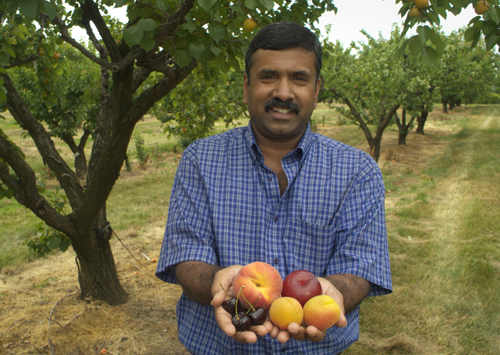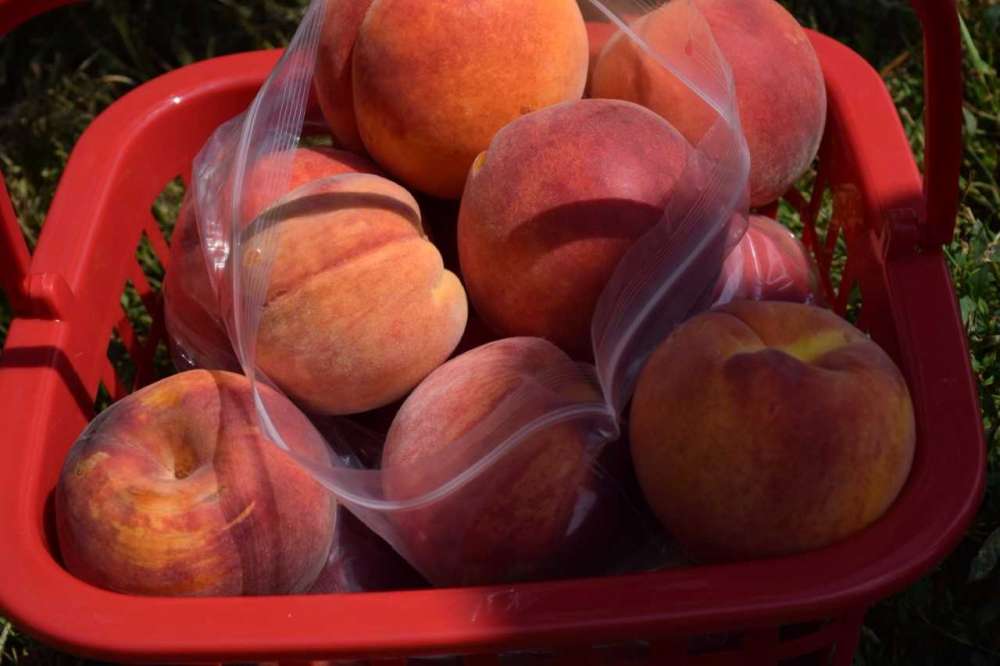
Ontario peaches with better colour, taste and texture, and that are available in stores two weeks earlier than other local peaches, is the goal of University of Guelph research.
Using molecular genetics, plant breeder Dr. Jay Subramanian has been developing new peach and plum varieties to appeal to both consumers and growers.
“We are looking to combine the best elements of a peach into a variety that will be ready for harvest sooner,” said the plant agriculture professor.
His aim has been to create an early fruiting variety that would hit the market at the same time as imported peaches — allowing Canadian consumers to support local farmers for the whole peach season.
He developed a peach variety called Veeblush that has the desired taste and colour but also matures quickly. It was made available to orchards five years ago and is already in high demand among Niagara peach growers.
With two more early-fruiting varieties in the pipeline this year, and as many as six by 2025, Subramanian’s vision for an Ontario-centric peach market is within reach — and much sooner thanks to his research.
Subramanian has streamlined the genetic selection process to quickly determine the genes that affect peach fruit development. His refined molecular breeding process reduces the time needed to perfect fruit, from 25-30 years down to 10 or 12.
Streamlining is key because there are about 30,000 genes in the peach genome and Subramanian investigates more than 350 peach types.
By using a technique called a genome-wide association study, he can zero in on the peach traits he and fruit producers want and develop new hybrids using a fast hybridization process.
 Traditional plant breeding meant raising seedlings into mature fruiting trees to find the breeds with the best-looking and -tasting fruits that also produce the earliest yield. Subramanian can run a polymerase chain reaction (PCR) on a leaf from each seedling, a process that amplifies a small sample of DNA into an amount large enough to be studied in detail. From the PCR, he can identify the small handful of plants carrying the early fruiting gene along with other desirable taste and colour traits.
Traditional plant breeding meant raising seedlings into mature fruiting trees to find the breeds with the best-looking and -tasting fruits that also produce the earliest yield. Subramanian can run a polymerase chain reaction (PCR) on a leaf from each seedling, a process that amplifies a small sample of DNA into an amount large enough to be studied in detail. From the PCR, he can identify the small handful of plants carrying the early fruiting gene along with other desirable taste and colour traits.
By raising only these plants, producers can shorten the genetic selection process from the 10 years it takes to raise a fruiting tree to the few months it takes a seed to become a seedling.
“This saves producers a lot of time and space,” said Subramanian. “If you were to plant and raise 5,000 peach trees, you would need 20 acres and 10-plus years, whereas the hand-selected group of seedlings would likely only require one row, and you could be sure they all have the traits you want.”
What’s more, molecular breeding means researchers can also determine which peach varieties will be most resistant to certain diseases.
His next project is to reduce the spread of black knot disease, the most devastating fungal disease affecting plum varieties. By sequencing RNA – the molecule responsible for regulating and expressing genes – Subramanian looks for disease resistance markers, or sequences in RNA that correlate to lower susceptibility to diseases like black knot.
He also hopes to extend peach shelf life through genetic selection via RNA sequencing.
“By identifying small mutations that have a huge impact, we can get closer to perfecting Ontario peaches,” he said.
Subramanian works with researchers at the Vineland Research and Innovation Centre. Funding is provided by the Ontario Tender Fruit Producers Marketing Board, the Niagara Peninsula Fruit and Vegetable Growers’ Association, the Ontario Ministry of Agriculture, Food and Rural Affairs, and the Innovation Superclusters Initiative.
Contact:
Dr. Jay Subramanian
jsubrama@uoguelph.ca
As Canada’s food university, the University of Guelph is shining a light on all the ways we are supporting and improving Canada’s food systems in celebration of Food Day Canada on July 31. Visit U of G’s Food Day Canada page to learn more.